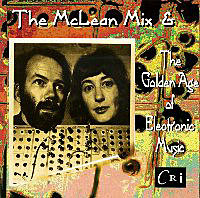The McLean Mix – The Golden Age of Electronic Music

Husband and wife duo Barton and Priscilla McLean have been at it since the early ’70s, and this CD reissues a couple of old Folkways and CRI LPs from that decade. “A central focus of their often abstract electro-acoustic music has been sounds and images of nature and primal forces of creation. The Golden Age of Electronic Music refers to the period of the ’70s when analog synthesizers were at their most powerful and many fascinating works were being created using these with multi-track reel-to-reel tape recorders, noise-reducing equipment, analog processors and large mixers. The equipment, large and cumbersome, spanned the four walls of the studio and the composers would often run back and forth between stations, spending as many as 22 hours at a time to develop one complex sound.”
Mostly realized at the Electronic Music Center of Indiana University at South Bend and the McLean’s home studio in Austin, Texas, many of the pieces on this CD have been performed live on tour by The McLean Mix over the decades, with two of them—“Dance Of The Dawn” and “Etunytude”—being included in college electronic music curricula. In Priscilla McLean’s “Invisible Chariots” (1975-77) concrète sounds in the form of tennis balls bounced on piano strings, bowed piano strings and a steak knife bounced on violin strings are intermingled with classic synth pulses, blurps and distant washes. Barton McLean’s “Songs Of The Nahuatl” (1976) is a quiet closet full of whistling, droning, high-pitched synth melodies that “questions humankind’s relationship to the natural world. The musical figures, the foreground melodies, grow out of and are finally absorbed back into the all-pervading nature sounds, which continue forever. The central part of the work depicts our egocentricity, as the melodies organically grow and soar, but the underlying ‘nature’ forces are always present in veiled, choir-like or fluctuating chords or ostinati, that ultimately prevail.”
Priscilla’s “Dance Of The Dawn” (1974) is filled with quiet, warbling electronic shimmers and high-pitched beeping; queasy reverberations; almost Dockstader-like start / stop synth explosions; quiet, skittering sounds and drones, plus a bit of synth-drumming. Another of Priscilla’s pieces, “Night Images” (1973) is “their first totally electronic work created on two small analog synthesizers. Three main ideas dominate: a life-pulse; a murmuring, dreamy background sequence; and a trumpet-like melody that metamorphosizes.” “In 1982, Barton was director of the University of Texas at Austin Electronic Music Center when he composed ‘Etunytude’ on the Fairlight CMI, the first commercial instrument to have a digital music sampler and a light pen to draw waves on the screen. In honor of the occasion, Barton created this work by drawing sine waves on a TV screen, often producing melodies or complex harmonies sometimes resulting in a beautiful ‘turning-in-space’ effect that is part harmony and part melody intertwined. The title refers to the piece’s tunefulness as well as it’s etude-like character.”
Label: CRI Catalog Number: CD-764 Format: CD Packaging: Jewel case Tracks: 7 Total Time: 72:57 Country: United States Released: 1997 Related Artists: Mother Mallard’s Portable Masterpiece Company, Laurie Spiegel More Official
Leave a Reply